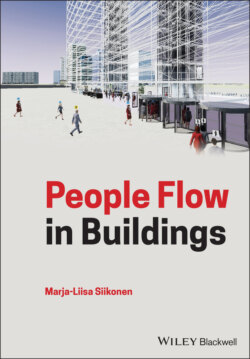Читать книгу People Flow in Buildings - Marja-Liisa Siikonen - Страница 27
На сайте Литреса книга снята с продажи.
2.5 Visitor‐counting with Photocell Signals and Infra‐red Beams
ОглавлениеIn building entrances and doorways of transportation devices such as buses, tramways and trains (Pinna et al. 2010 ), in elevators and escalators, photocell devices, ultrasonic detectors, or infra‐red beam detectors or light‐curtains are often used as safety devices. If someone is detected in between or in close proximity to the doors, the doors are prohibited from being closed. The photocell signals can also be used to count passengers, or to start an escalator being in standby mode. A passenger moving through a doorway causes a cut in the photocell signal. With one pair of devices the direction of the passenger transfer, however, cannot be distinguished. To determine the direction of movement, at least two signals, a light‐curtain (Figure 2.3a), or a proximity sensor are needed (Figure 2.3b). A two‐dimensional (2D) light‐curtain has transmitters of infra‐red beams on one side of the door opening, and receivers on the other side of the opening. A light‐curtain can recognize passengers as long as they are in between the doors. This provides comfort, e.g. for disabled people for whom the untimely closing of doors causes problems. In a three‐dimensional (3D) proximity sensor, some infrared transmitters and receivers are set at an angle where the beams reflect from the obstacle back to the receivers. When the doors start to close, the area recognized by the proximity sensor decreases (Strakosch and Caporale 2010 ). Advanced proximity sensors can detect a passenger and estimate the distance as well as the direction of the passenger movement (Backlund 2015 ).
Figure 2.3 Curtain‐of‐light (a), and infra‐red proximity sensor (b) in a door opening.
